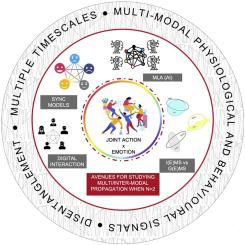Neuroscience & Biobehavioral Reviews ( IF 7.5 ) Pub Date : 2021-08-18 , DOI: 10.1016/j.neubiorev.2021.08.014 Marta M N Bieńkiewicz 1 , Andrii P Smykovskyi 1 , Temitayo Olugbade 2 , Stefan Janaqi 1 , Antonio Camurri 3 , Nadia Bianchi-Berthouze 2 , Mårten Björkman 4 , Benoît G Bardy 1

|
Our daily human life is filled with a myriad of joint action moments, be it children playing, adults working together (i.e., team sports), or strangers navigating through a crowd. Joint action brings individuals (and embodiment of their emotions) together, in space and in time. Yet little is known about how individual emotions propagate through embodied presence in a group, and how joint action changes individual emotion. In fact, the multi-agent component is largely missing from neuroscience-based approaches to emotion, and reversely joint action research has not found a way yet to include emotion as one of the key parameters to model socio-motor interaction. In this review, we first identify the gap and then stockpile evidence showing strong entanglement between emotion and acting together from various branches of sciences. We propose an integrative approach to bridge the gap, highlight five research avenues to do so in behavioral neuroscience and digital sciences, and address some of the key challenges in the area faced by modern societies.
中文翻译:

弥合情感和联合行动之间的差距
我们的日常生活充满了无数的联合行动时刻,无论是儿童玩耍、成年人一起工作(即团队运动),还是陌生人在人群中穿行。联合行动将个人(及其情感的体现)在空间和时间上聚集在一起。然而,人们对个体情绪如何通过群体中的具体存在传播,以及联合行动如何改变个体情绪知之甚少。事实上,基于神经科学的情感方法很大程度上缺少多智能体组件,反向联合行动研究还没有找到一种方法,将情感作为模拟社会运动交互的关键参数之一。在这篇综述中,我们首先确定了差距,然后从各个科学分支收集了表明情感和共同行动之间存在强烈纠葛的证据。











































 京公网安备 11010802027423号
京公网安备 11010802027423号